Financial Management Report on Dividend Policy and M&A Strategies
VerifiedAdded on 2020/06/04
|12
|3646
|25
Report
AI Summary
This report provides a comprehensive overview of financial management, focusing on dividend policy and mergers and acquisitions (M&A). It begins by defining the core objectives of financial management and the significance of dividend decisions in corporate finance. The report delves into various dividend policies, including those prioritizing long-term financing and wealth maximization, and discusses how these policies are governed. It then examines the relevance and irrelevance theories of dividend valuation, exploring models such as Walter's, Gordon's, and Modigliani-Miller's models. The report analyzes the assumptions and implications of each model, highlighting their impact on share valuation. Furthermore, the report discusses the role of M&A as a growth strategy in the contemporary business environment, emphasizing its importance in achieving market share and financial stability. Overall, the report offers valuable insights into the complexities of financial management and its practical application in the corporate world.
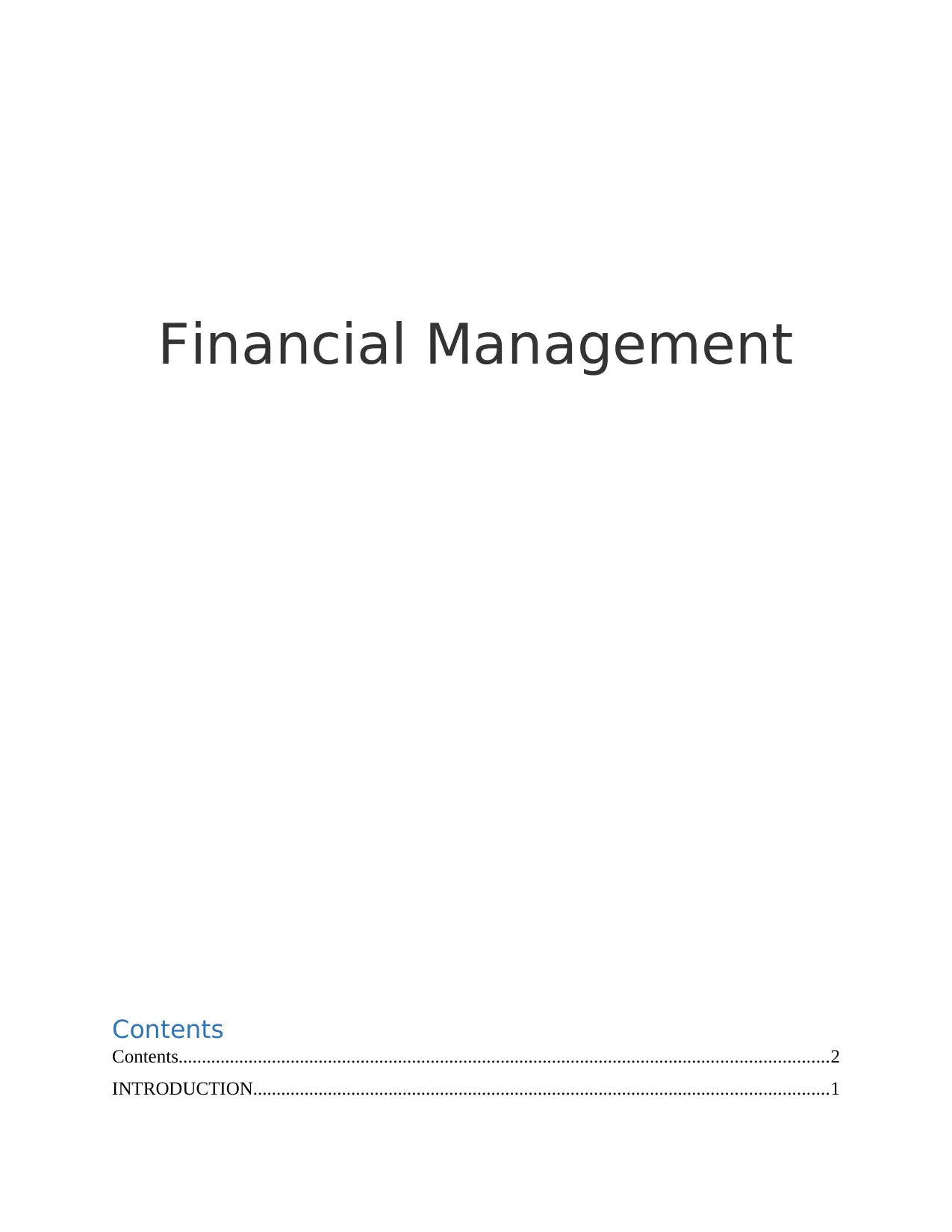
Financial Management
Contents
Contents...........................................................................................................................................2
INTRODUCTION...........................................................................................................................1
Contents
Contents...........................................................................................................................................2
INTRODUCTION...........................................................................................................................1
Paraphrase This Document
Need a fresh take? Get an instant paraphrase of this document with our AI Paraphraser

TASK...............................................................................................................................................1
Part A......................................................................................................................................1
Part C......................................................................................................................................5
CONCLUSION................................................................................................................................8
REFERENCES................................................................................................................................9
Part A......................................................................................................................................1
Part C......................................................................................................................................5
CONCLUSION................................................................................................................................8
REFERENCES................................................................................................................................9
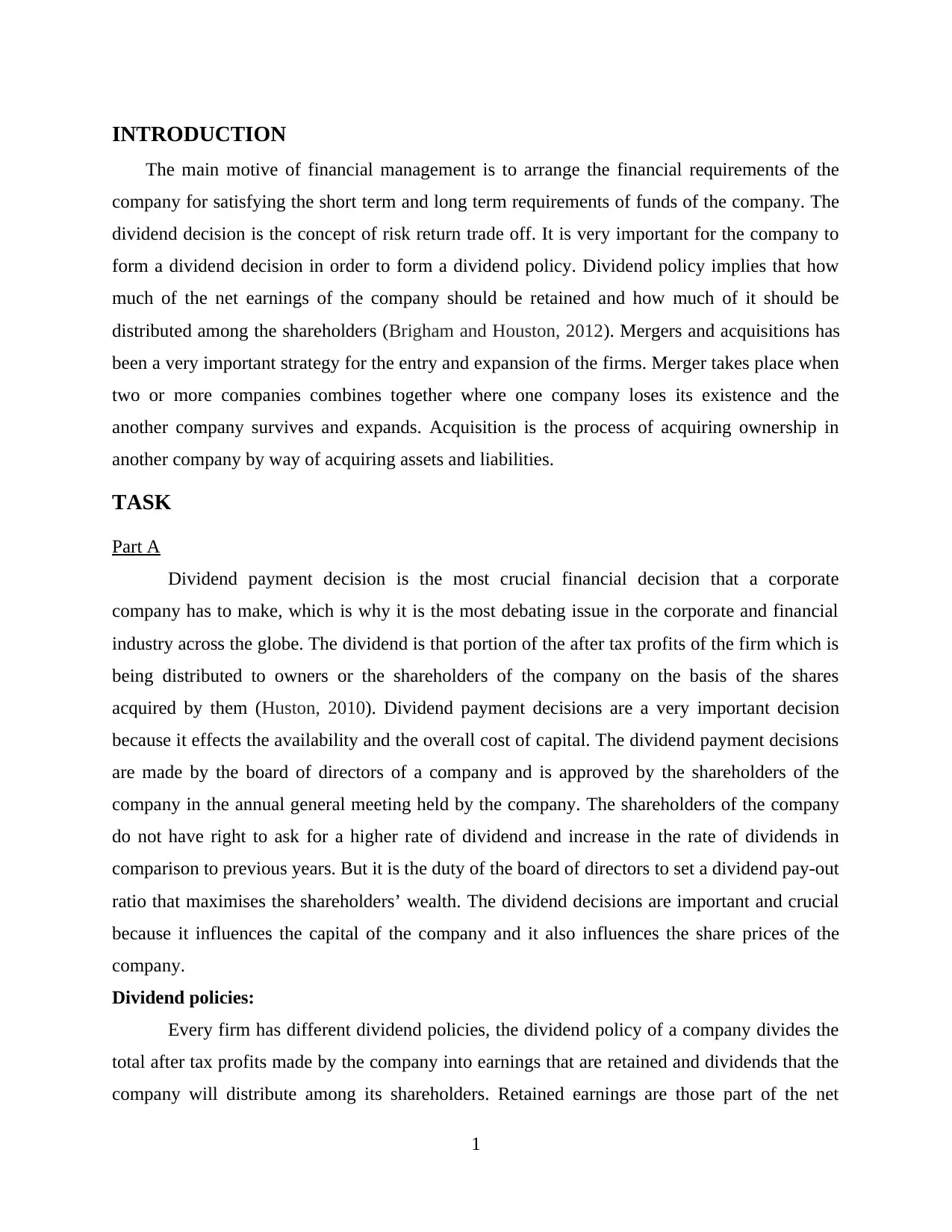
INTRODUCTION
The main motive of financial management is to arrange the financial requirements of the
company for satisfying the short term and long term requirements of funds of the company. The
dividend decision is the concept of risk return trade off. It is very important for the company to
form a dividend decision in order to form a dividend policy. Dividend policy implies that how
much of the net earnings of the company should be retained and how much of it should be
distributed among the shareholders (Brigham and Houston, 2012). Mergers and acquisitions has
been a very important strategy for the entry and expansion of the firms. Merger takes place when
two or more companies combines together where one company loses its existence and the
another company survives and expands. Acquisition is the process of acquiring ownership in
another company by way of acquiring assets and liabilities.
TASK
Part A
Dividend payment decision is the most crucial financial decision that a corporate
company has to make, which is why it is the most debating issue in the corporate and financial
industry across the globe. The dividend is that portion of the after tax profits of the firm which is
being distributed to owners or the shareholders of the company on the basis of the shares
acquired by them (Huston, 2010). Dividend payment decisions are a very important decision
because it effects the availability and the overall cost of capital. The dividend payment decisions
are made by the board of directors of a company and is approved by the shareholders of the
company in the annual general meeting held by the company. The shareholders of the company
do not have right to ask for a higher rate of dividend and increase in the rate of dividends in
comparison to previous years. But it is the duty of the board of directors to set a dividend pay-out
ratio that maximises the shareholders’ wealth. The dividend decisions are important and crucial
because it influences the capital of the company and it also influences the share prices of the
company.
Dividend policies:
Every firm has different dividend policies, the dividend policy of a company divides the
total after tax profits made by the company into earnings that are retained and dividends that the
company will distribute among its shareholders. Retained earnings are those part of the net
1
The main motive of financial management is to arrange the financial requirements of the
company for satisfying the short term and long term requirements of funds of the company. The
dividend decision is the concept of risk return trade off. It is very important for the company to
form a dividend decision in order to form a dividend policy. Dividend policy implies that how
much of the net earnings of the company should be retained and how much of it should be
distributed among the shareholders (Brigham and Houston, 2012). Mergers and acquisitions has
been a very important strategy for the entry and expansion of the firms. Merger takes place when
two or more companies combines together where one company loses its existence and the
another company survives and expands. Acquisition is the process of acquiring ownership in
another company by way of acquiring assets and liabilities.
TASK
Part A
Dividend payment decision is the most crucial financial decision that a corporate
company has to make, which is why it is the most debating issue in the corporate and financial
industry across the globe. The dividend is that portion of the after tax profits of the firm which is
being distributed to owners or the shareholders of the company on the basis of the shares
acquired by them (Huston, 2010). Dividend payment decisions are a very important decision
because it effects the availability and the overall cost of capital. The dividend payment decisions
are made by the board of directors of a company and is approved by the shareholders of the
company in the annual general meeting held by the company. The shareholders of the company
do not have right to ask for a higher rate of dividend and increase in the rate of dividends in
comparison to previous years. But it is the duty of the board of directors to set a dividend pay-out
ratio that maximises the shareholders’ wealth. The dividend decisions are important and crucial
because it influences the capital of the company and it also influences the share prices of the
company.
Dividend policies:
Every firm has different dividend policies, the dividend policy of a company divides the
total after tax profits made by the company into earnings that are retained and dividends that the
company will distribute among its shareholders. Retained earnings are those part of the net
1
⊘ This is a preview!⊘
Do you want full access?
Subscribe today to unlock all pages.

Trusted by 1+ million students worldwide
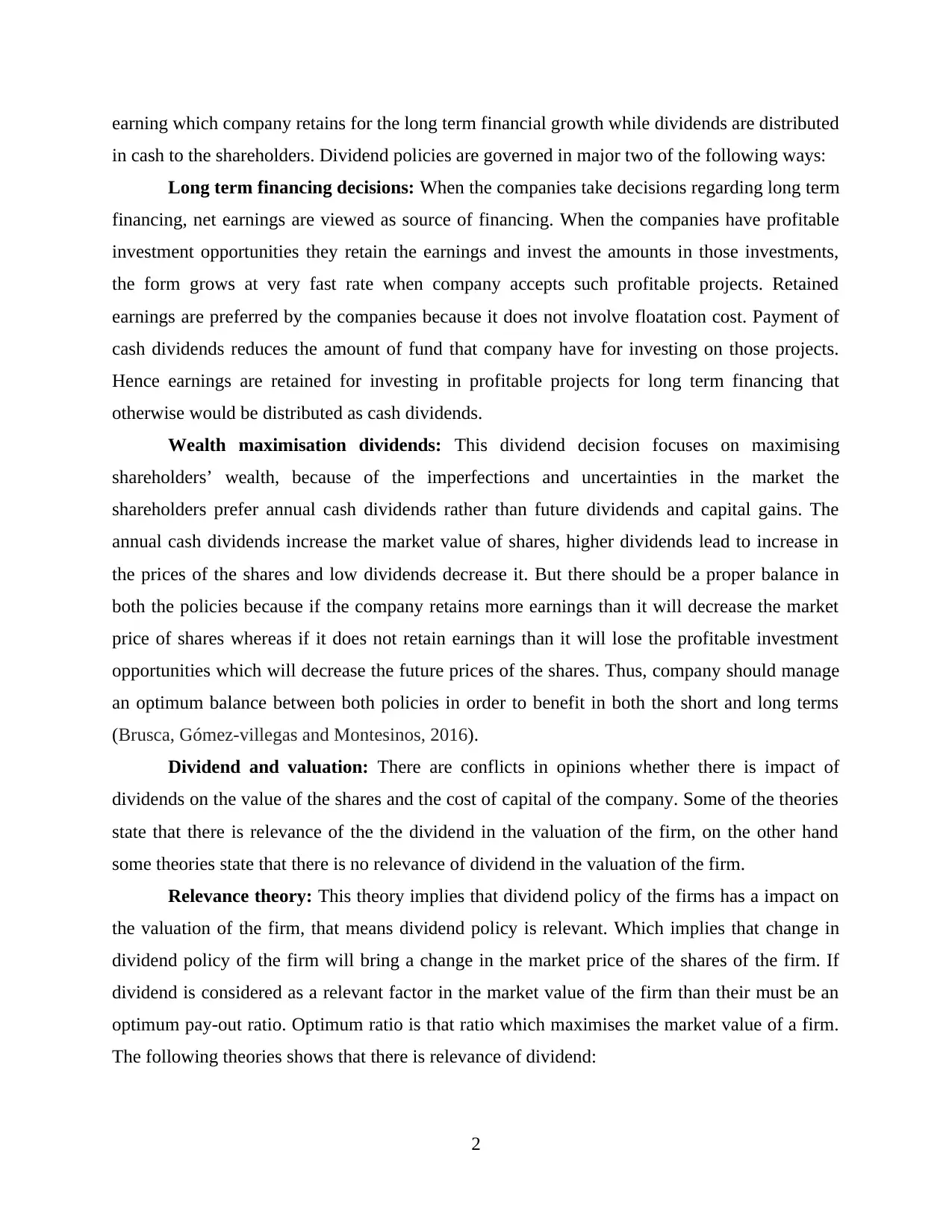
earning which company retains for the long term financial growth while dividends are distributed
in cash to the shareholders. Dividend policies are governed in major two of the following ways:
Long term financing decisions: When the companies take decisions regarding long term
financing, net earnings are viewed as source of financing. When the companies have profitable
investment opportunities they retain the earnings and invest the amounts in those investments,
the form grows at very fast rate when company accepts such profitable projects. Retained
earnings are preferred by the companies because it does not involve floatation cost. Payment of
cash dividends reduces the amount of fund that company have for investing on those projects.
Hence earnings are retained for investing in profitable projects for long term financing that
otherwise would be distributed as cash dividends.
Wealth maximisation dividends: This dividend decision focuses on maximising
shareholders’ wealth, because of the imperfections and uncertainties in the market the
shareholders prefer annual cash dividends rather than future dividends and capital gains. The
annual cash dividends increase the market value of shares, higher dividends lead to increase in
the prices of the shares and low dividends decrease it. But there should be a proper balance in
both the policies because if the company retains more earnings than it will decrease the market
price of shares whereas if it does not retain earnings than it will lose the profitable investment
opportunities which will decrease the future prices of the shares. Thus, company should manage
an optimum balance between both policies in order to benefit in both the short and long terms
(Brusca, Gómez‐villegas and Montesinos, 2016).
Dividend and valuation: There are conflicts in opinions whether there is impact of
dividends on the value of the shares and the cost of capital of the company. Some of the theories
state that there is relevance of the the dividend in the valuation of the firm, on the other hand
some theories state that there is no relevance of dividend in the valuation of the firm.
Relevance theory: This theory implies that dividend policy of the firms has a impact on
the valuation of the firm, that means dividend policy is relevant. Which implies that change in
dividend policy of the firm will bring a change in the market price of the shares of the firm. If
dividend is considered as a relevant factor in the market value of the firm than their must be an
optimum pay-out ratio. Optimum ratio is that ratio which maximises the market value of a firm.
The following theories shows that there is relevance of dividend:
2
in cash to the shareholders. Dividend policies are governed in major two of the following ways:
Long term financing decisions: When the companies take decisions regarding long term
financing, net earnings are viewed as source of financing. When the companies have profitable
investment opportunities they retain the earnings and invest the amounts in those investments,
the form grows at very fast rate when company accepts such profitable projects. Retained
earnings are preferred by the companies because it does not involve floatation cost. Payment of
cash dividends reduces the amount of fund that company have for investing on those projects.
Hence earnings are retained for investing in profitable projects for long term financing that
otherwise would be distributed as cash dividends.
Wealth maximisation dividends: This dividend decision focuses on maximising
shareholders’ wealth, because of the imperfections and uncertainties in the market the
shareholders prefer annual cash dividends rather than future dividends and capital gains. The
annual cash dividends increase the market value of shares, higher dividends lead to increase in
the prices of the shares and low dividends decrease it. But there should be a proper balance in
both the policies because if the company retains more earnings than it will decrease the market
price of shares whereas if it does not retain earnings than it will lose the profitable investment
opportunities which will decrease the future prices of the shares. Thus, company should manage
an optimum balance between both policies in order to benefit in both the short and long terms
(Brusca, Gómez‐villegas and Montesinos, 2016).
Dividend and valuation: There are conflicts in opinions whether there is impact of
dividends on the value of the shares and the cost of capital of the company. Some of the theories
state that there is relevance of the the dividend in the valuation of the firm, on the other hand
some theories state that there is no relevance of dividend in the valuation of the firm.
Relevance theory: This theory implies that dividend policy of the firms has a impact on
the valuation of the firm, that means dividend policy is relevant. Which implies that change in
dividend policy of the firm will bring a change in the market price of the shares of the firm. If
dividend is considered as a relevant factor in the market value of the firm than their must be an
optimum pay-out ratio. Optimum ratio is that ratio which maximises the market value of a firm.
The following theories shows that there is relevance of dividend:
2
Paraphrase This Document
Need a fresh take? Get an instant paraphrase of this document with our AI Paraphraser
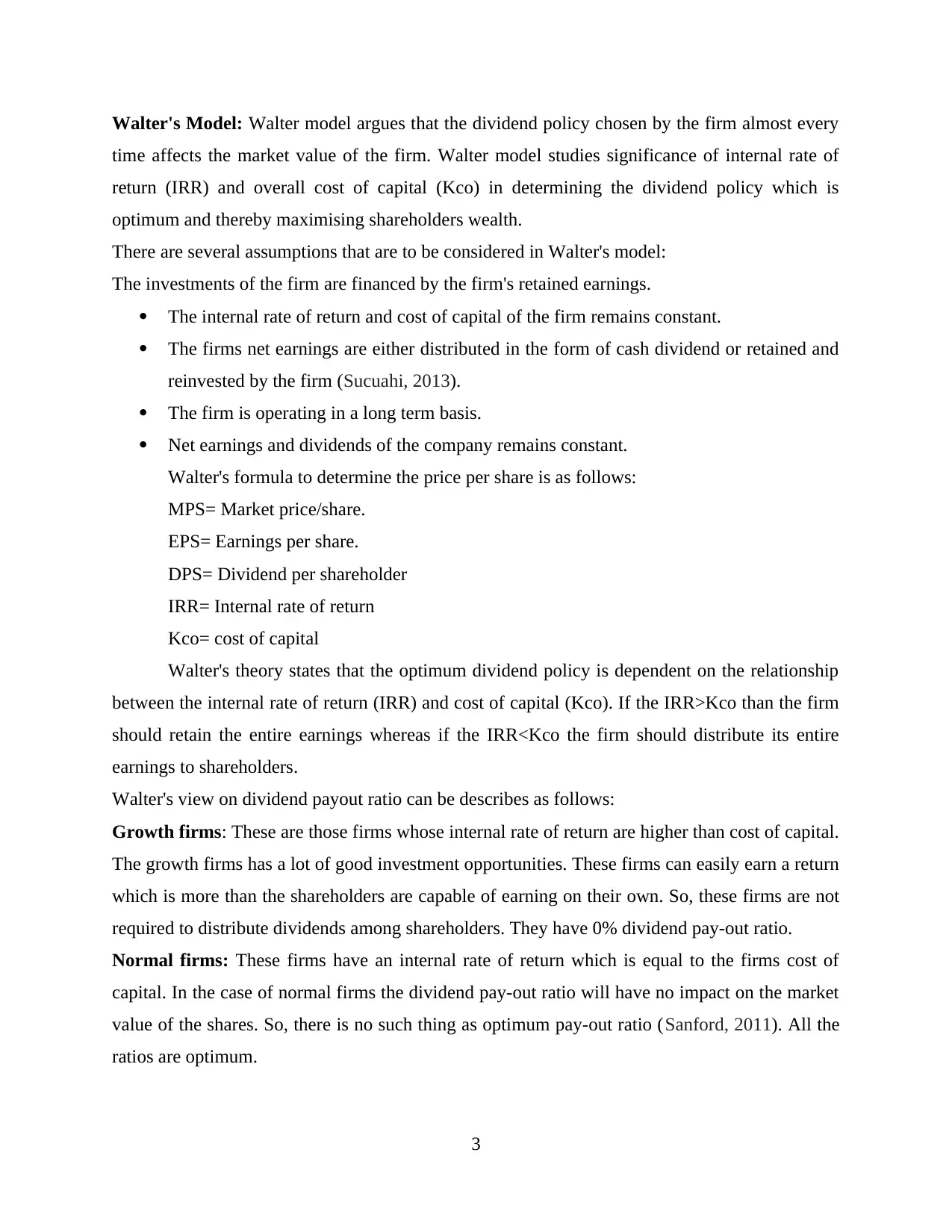
Walter's Model: Walter model argues that the dividend policy chosen by the firm almost every
time affects the market value of the firm. Walter model studies significance of internal rate of
return (IRR) and overall cost of capital (Kco) in determining the dividend policy which is
optimum and thereby maximising shareholders wealth.
There are several assumptions that are to be considered in Walter's model:
The investments of the firm are financed by the firm's retained earnings.
The internal rate of return and cost of capital of the firm remains constant.
The firms net earnings are either distributed in the form of cash dividend or retained and
reinvested by the firm (Sucuahi, 2013).
The firm is operating in a long term basis.
Net earnings and dividends of the company remains constant.
Walter's formula to determine the price per share is as follows:
MPS= Market price/share.
EPS= Earnings per share.
DPS= Dividend per shareholder
IRR= Internal rate of return
Kco= cost of capital
Walter's theory states that the optimum dividend policy is dependent on the relationship
between the internal rate of return (IRR) and cost of capital (Kco). If the IRR>Kco than the firm
should retain the entire earnings whereas if the IRR<Kco the firm should distribute its entire
earnings to shareholders.
Walter's view on dividend payout ratio can be describes as follows:
Growth firms: These are those firms whose internal rate of return are higher than cost of capital.
The growth firms has a lot of good investment opportunities. These firms can easily earn a return
which is more than the shareholders are capable of earning on their own. So, these firms are not
required to distribute dividends among shareholders. They have 0% dividend pay-out ratio.
Normal firms: These firms have an internal rate of return which is equal to the firms cost of
capital. In the case of normal firms the dividend pay-out ratio will have no impact on the market
value of the shares. So, there is no such thing as optimum pay-out ratio (Sanford, 2011). All the
ratios are optimum.
3
time affects the market value of the firm. Walter model studies significance of internal rate of
return (IRR) and overall cost of capital (Kco) in determining the dividend policy which is
optimum and thereby maximising shareholders wealth.
There are several assumptions that are to be considered in Walter's model:
The investments of the firm are financed by the firm's retained earnings.
The internal rate of return and cost of capital of the firm remains constant.
The firms net earnings are either distributed in the form of cash dividend or retained and
reinvested by the firm (Sucuahi, 2013).
The firm is operating in a long term basis.
Net earnings and dividends of the company remains constant.
Walter's formula to determine the price per share is as follows:
MPS= Market price/share.
EPS= Earnings per share.
DPS= Dividend per shareholder
IRR= Internal rate of return
Kco= cost of capital
Walter's theory states that the optimum dividend policy is dependent on the relationship
between the internal rate of return (IRR) and cost of capital (Kco). If the IRR>Kco than the firm
should retain the entire earnings whereas if the IRR<Kco the firm should distribute its entire
earnings to shareholders.
Walter's view on dividend payout ratio can be describes as follows:
Growth firms: These are those firms whose internal rate of return are higher than cost of capital.
The growth firms has a lot of good investment opportunities. These firms can easily earn a return
which is more than the shareholders are capable of earning on their own. So, these firms are not
required to distribute dividends among shareholders. They have 0% dividend pay-out ratio.
Normal firms: These firms have an internal rate of return which is equal to the firms cost of
capital. In the case of normal firms the dividend pay-out ratio will have no impact on the market
value of the shares. So, there is no such thing as optimum pay-out ratio (Sanford, 2011). All the
ratios are optimum.
3
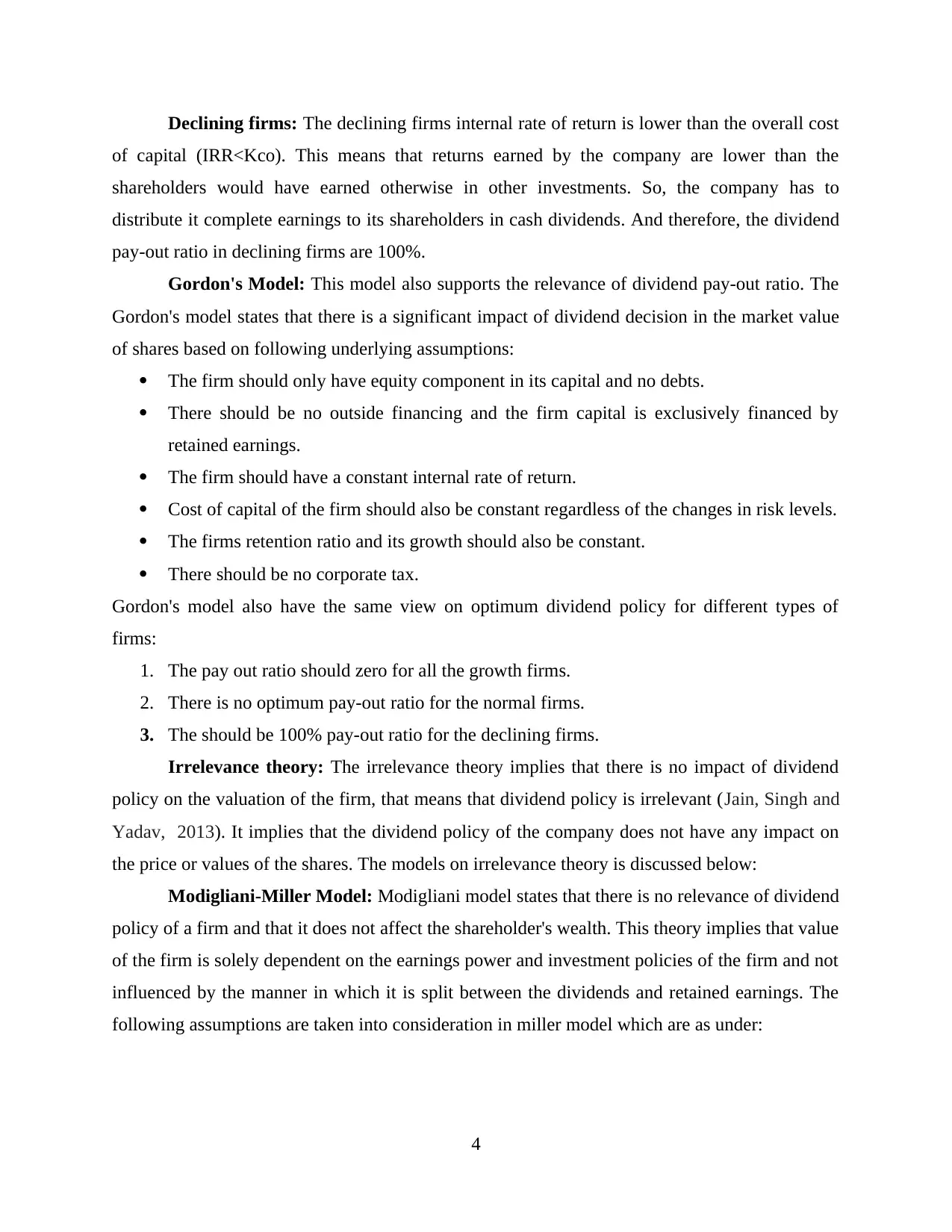
Declining firms: The declining firms internal rate of return is lower than the overall cost
of capital (IRR<Kco). This means that returns earned by the company are lower than the
shareholders would have earned otherwise in other investments. So, the company has to
distribute it complete earnings to its shareholders in cash dividends. And therefore, the dividend
pay-out ratio in declining firms are 100%.
Gordon's Model: This model also supports the relevance of dividend pay-out ratio. The
Gordon's model states that there is a significant impact of dividend decision in the market value
of shares based on following underlying assumptions:
The firm should only have equity component in its capital and no debts.
There should be no outside financing and the firm capital is exclusively financed by
retained earnings.
The firm should have a constant internal rate of return.
Cost of capital of the firm should also be constant regardless of the changes in risk levels.
The firms retention ratio and its growth should also be constant.
There should be no corporate tax.
Gordon's model also have the same view on optimum dividend policy for different types of
firms:
1. The pay out ratio should zero for all the growth firms.
2. There is no optimum pay-out ratio for the normal firms.
3. The should be 100% pay-out ratio for the declining firms.
Irrelevance theory: The irrelevance theory implies that there is no impact of dividend
policy on the valuation of the firm, that means that dividend policy is irrelevant (Jain, Singh and
Yadav, 2013). It implies that the dividend policy of the company does not have any impact on
the price or values of the shares. The models on irrelevance theory is discussed below:
Modigliani-Miller Model: Modigliani model states that there is no relevance of dividend
policy of a firm and that it does not affect the shareholder's wealth. This theory implies that value
of the firm is solely dependent on the earnings power and investment policies of the firm and not
influenced by the manner in which it is split between the dividends and retained earnings. The
following assumptions are taken into consideration in miller model which are as under:
4
of capital (IRR<Kco). This means that returns earned by the company are lower than the
shareholders would have earned otherwise in other investments. So, the company has to
distribute it complete earnings to its shareholders in cash dividends. And therefore, the dividend
pay-out ratio in declining firms are 100%.
Gordon's Model: This model also supports the relevance of dividend pay-out ratio. The
Gordon's model states that there is a significant impact of dividend decision in the market value
of shares based on following underlying assumptions:
The firm should only have equity component in its capital and no debts.
There should be no outside financing and the firm capital is exclusively financed by
retained earnings.
The firm should have a constant internal rate of return.
Cost of capital of the firm should also be constant regardless of the changes in risk levels.
The firms retention ratio and its growth should also be constant.
There should be no corporate tax.
Gordon's model also have the same view on optimum dividend policy for different types of
firms:
1. The pay out ratio should zero for all the growth firms.
2. There is no optimum pay-out ratio for the normal firms.
3. The should be 100% pay-out ratio for the declining firms.
Irrelevance theory: The irrelevance theory implies that there is no impact of dividend
policy on the valuation of the firm, that means that dividend policy is irrelevant (Jain, Singh and
Yadav, 2013). It implies that the dividend policy of the company does not have any impact on
the price or values of the shares. The models on irrelevance theory is discussed below:
Modigliani-Miller Model: Modigliani model states that there is no relevance of dividend
policy of a firm and that it does not affect the shareholder's wealth. This theory implies that value
of the firm is solely dependent on the earnings power and investment policies of the firm and not
influenced by the manner in which it is split between the dividends and retained earnings. The
following assumptions are taken into consideration in miller model which are as under:
4
⊘ This is a preview!⊘
Do you want full access?
Subscribe today to unlock all pages.

Trusted by 1+ million students worldwide
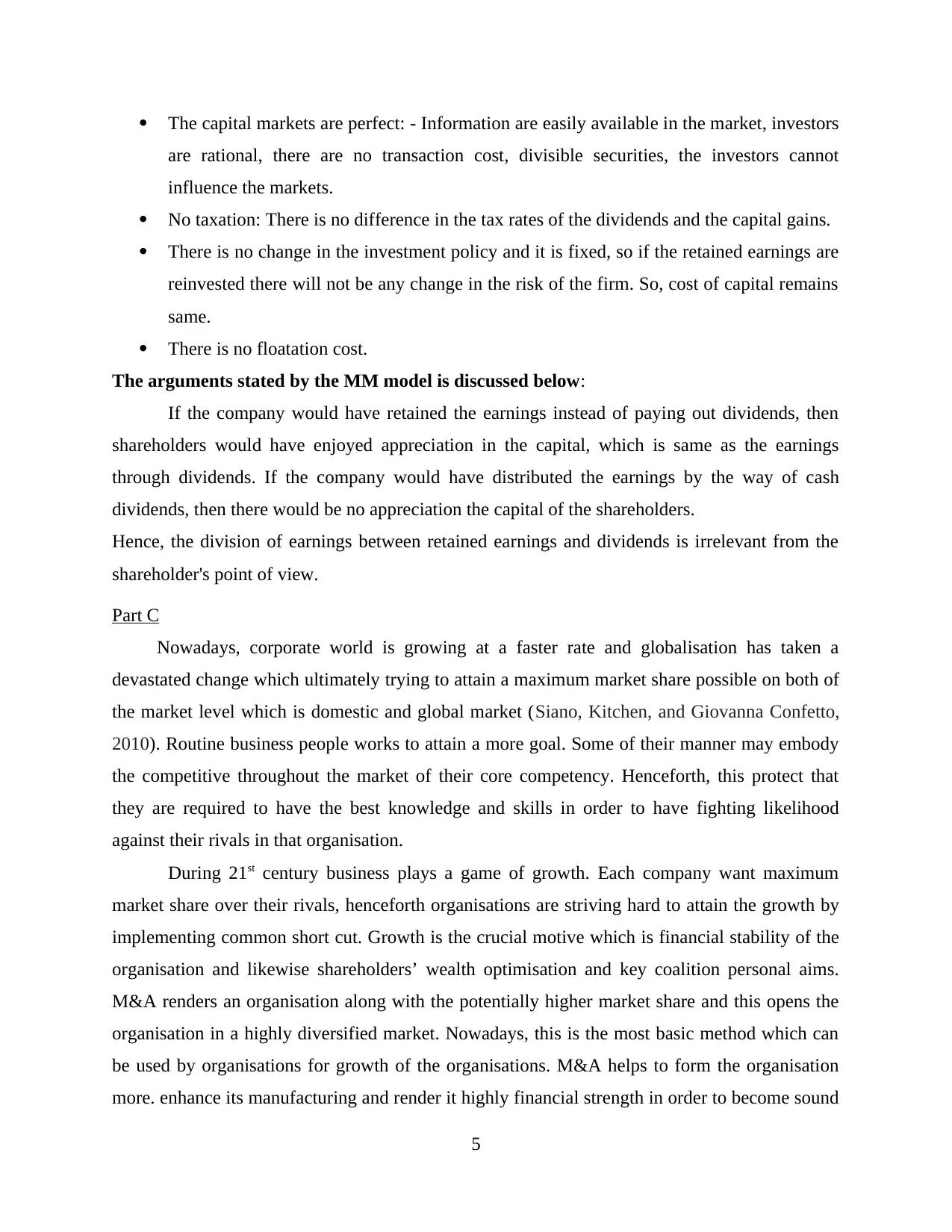
The capital markets are perfect: - Information are easily available in the market, investors
are rational, there are no transaction cost, divisible securities, the investors cannot
influence the markets.
No taxation: There is no difference in the tax rates of the dividends and the capital gains.
There is no change in the investment policy and it is fixed, so if the retained earnings are
reinvested there will not be any change in the risk of the firm. So, cost of capital remains
same.
There is no floatation cost.
The arguments stated by the MM model is discussed below:
If the company would have retained the earnings instead of paying out dividends, then
shareholders would have enjoyed appreciation in the capital, which is same as the earnings
through dividends. If the company would have distributed the earnings by the way of cash
dividends, then there would be no appreciation the capital of the shareholders.
Hence, the division of earnings between retained earnings and dividends is irrelevant from the
shareholder's point of view.
Part C
Nowadays, corporate world is growing at a faster rate and globalisation has taken a
devastated change which ultimately trying to attain a maximum market share possible on both of
the market level which is domestic and global market (Siano, Kitchen, and Giovanna Confetto,
2010). Routine business people works to attain a more goal. Some of their manner may embody
the competitive throughout the market of their core competency. Henceforth, this protect that
they are required to have the best knowledge and skills in order to have fighting likelihood
against their rivals in that organisation.
During 21st century business plays a game of growth. Each company want maximum
market share over their rivals, henceforth organisations are striving hard to attain the growth by
implementing common short cut. Growth is the crucial motive which is financial stability of the
organisation and likewise shareholders’ wealth optimisation and key coalition personal aims.
M&A renders an organisation along with the potentially higher market share and this opens the
organisation in a highly diversified market. Nowadays, this is the most basic method which can
be used by organisations for growth of the organisations. M&A helps to form the organisation
more. enhance its manufacturing and render it highly financial strength in order to become sound
5
are rational, there are no transaction cost, divisible securities, the investors cannot
influence the markets.
No taxation: There is no difference in the tax rates of the dividends and the capital gains.
There is no change in the investment policy and it is fixed, so if the retained earnings are
reinvested there will not be any change in the risk of the firm. So, cost of capital remains
same.
There is no floatation cost.
The arguments stated by the MM model is discussed below:
If the company would have retained the earnings instead of paying out dividends, then
shareholders would have enjoyed appreciation in the capital, which is same as the earnings
through dividends. If the company would have distributed the earnings by the way of cash
dividends, then there would be no appreciation the capital of the shareholders.
Hence, the division of earnings between retained earnings and dividends is irrelevant from the
shareholder's point of view.
Part C
Nowadays, corporate world is growing at a faster rate and globalisation has taken a
devastated change which ultimately trying to attain a maximum market share possible on both of
the market level which is domestic and global market (Siano, Kitchen, and Giovanna Confetto,
2010). Routine business people works to attain a more goal. Some of their manner may embody
the competitive throughout the market of their core competency. Henceforth, this protect that
they are required to have the best knowledge and skills in order to have fighting likelihood
against their rivals in that organisation.
During 21st century business plays a game of growth. Each company want maximum
market share over their rivals, henceforth organisations are striving hard to attain the growth by
implementing common short cut. Growth is the crucial motive which is financial stability of the
organisation and likewise shareholders’ wealth optimisation and key coalition personal aims.
M&A renders an organisation along with the potentially higher market share and this opens the
organisation in a highly diversified market. Nowadays, this is the most basic method which can
be used by organisations for growth of the organisations. M&A helps to form the organisation
more. enhance its manufacturing and render it highly financial strength in order to become sound
5
Paraphrase This Document
Need a fresh take? Get an instant paraphrase of this document with our AI Paraphraser
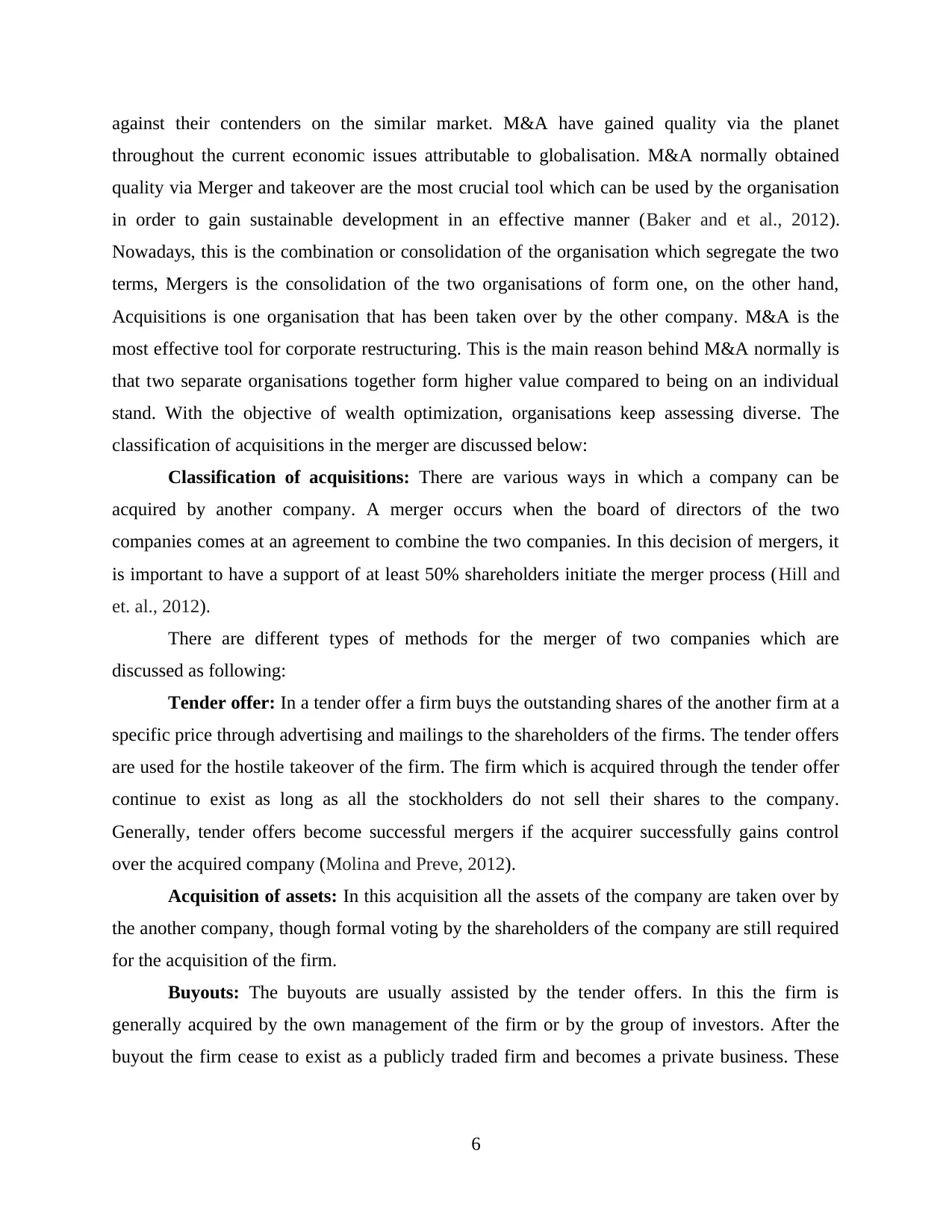
against their contenders on the similar market. M&A have gained quality via the planet
throughout the current economic issues attributable to globalisation. M&A normally obtained
quality via Merger and takeover are the most crucial tool which can be used by the organisation
in order to gain sustainable development in an effective manner (Baker and et al., 2012).
Nowadays, this is the combination or consolidation of the organisation which segregate the two
terms, Mergers is the consolidation of the two organisations of form one, on the other hand,
Acquisitions is one organisation that has been taken over by the other company. M&A is the
most effective tool for corporate restructuring. This is the main reason behind M&A normally is
that two separate organisations together form higher value compared to being on an individual
stand. With the objective of wealth optimization, organisations keep assessing diverse. The
classification of acquisitions in the merger are discussed below:
Classification of acquisitions: There are various ways in which a company can be
acquired by another company. A merger occurs when the board of directors of the two
companies comes at an agreement to combine the two companies. In this decision of mergers, it
is important to have a support of at least 50% shareholders initiate the merger process (Hill and
et. al., 2012).
There are different types of methods for the merger of two companies which are
discussed as following:
Tender offer: In a tender offer a firm buys the outstanding shares of the another firm at a
specific price through advertising and mailings to the shareholders of the firms. The tender offers
are used for the hostile takeover of the firm. The firm which is acquired through the tender offer
continue to exist as long as all the stockholders do not sell their shares to the company.
Generally, tender offers become successful mergers if the acquirer successfully gains control
over the acquired company (Molina and Preve, 2012).
Acquisition of assets: In this acquisition all the assets of the company are taken over by
the another company, though formal voting by the shareholders of the company are still required
for the acquisition of the firm.
Buyouts: The buyouts are usually assisted by the tender offers. In this the firm is
generally acquired by the own management of the firm or by the group of investors. After the
buyout the firm cease to exist as a publicly traded firm and becomes a private business. These
6
throughout the current economic issues attributable to globalisation. M&A normally obtained
quality via Merger and takeover are the most crucial tool which can be used by the organisation
in order to gain sustainable development in an effective manner (Baker and et al., 2012).
Nowadays, this is the combination or consolidation of the organisation which segregate the two
terms, Mergers is the consolidation of the two organisations of form one, on the other hand,
Acquisitions is one organisation that has been taken over by the other company. M&A is the
most effective tool for corporate restructuring. This is the main reason behind M&A normally is
that two separate organisations together form higher value compared to being on an individual
stand. With the objective of wealth optimization, organisations keep assessing diverse. The
classification of acquisitions in the merger are discussed below:
Classification of acquisitions: There are various ways in which a company can be
acquired by another company. A merger occurs when the board of directors of the two
companies comes at an agreement to combine the two companies. In this decision of mergers, it
is important to have a support of at least 50% shareholders initiate the merger process (Hill and
et. al., 2012).
There are different types of methods for the merger of two companies which are
discussed as following:
Tender offer: In a tender offer a firm buys the outstanding shares of the another firm at a
specific price through advertising and mailings to the shareholders of the firms. The tender offers
are used for the hostile takeover of the firm. The firm which is acquired through the tender offer
continue to exist as long as all the stockholders do not sell their shares to the company.
Generally, tender offers become successful mergers if the acquirer successfully gains control
over the acquired company (Molina and Preve, 2012).
Acquisition of assets: In this acquisition all the assets of the company are taken over by
the another company, though formal voting by the shareholders of the company are still required
for the acquisition of the firm.
Buyouts: The buyouts are usually assisted by the tender offers. In this the firm is
generally acquired by the own management of the firm or by the group of investors. After the
buyout the firm cease to exist as a publicly traded firm and becomes a private business. These
6
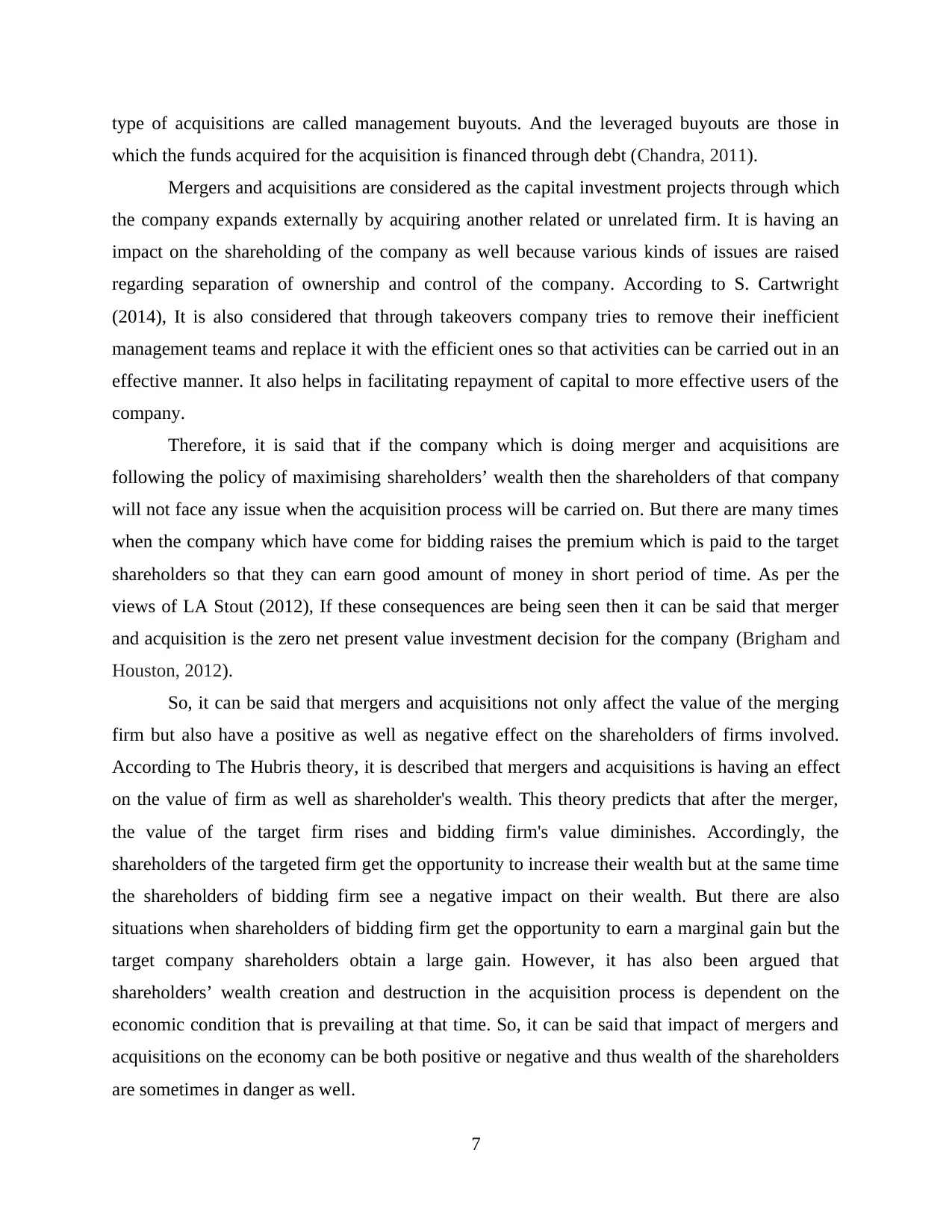
type of acquisitions are called management buyouts. And the leveraged buyouts are those in
which the funds acquired for the acquisition is financed through debt (Chandra, 2011).
Mergers and acquisitions are considered as the capital investment projects through which
the company expands externally by acquiring another related or unrelated firm. It is having an
impact on the shareholding of the company as well because various kinds of issues are raised
regarding separation of ownership and control of the company. According to S. Cartwright
(2014), It is also considered that through takeovers company tries to remove their inefficient
management teams and replace it with the efficient ones so that activities can be carried out in an
effective manner. It also helps in facilitating repayment of capital to more effective users of the
company.
Therefore, it is said that if the company which is doing merger and acquisitions are
following the policy of maximising shareholders’ wealth then the shareholders of that company
will not face any issue when the acquisition process will be carried on. But there are many times
when the company which have come for bidding raises the premium which is paid to the target
shareholders so that they can earn good amount of money in short period of time. As per the
views of LA Stout (2012), If these consequences are being seen then it can be said that merger
and acquisition is the zero net present value investment decision for the company (Brigham and
Houston, 2012).
So, it can be said that mergers and acquisitions not only affect the value of the merging
firm but also have a positive as well as negative effect on the shareholders of firms involved.
According to The Hubris theory, it is described that mergers and acquisitions is having an effect
on the value of firm as well as shareholder's wealth. This theory predicts that after the merger,
the value of the target firm rises and bidding firm's value diminishes. Accordingly, the
shareholders of the targeted firm get the opportunity to increase their wealth but at the same time
the shareholders of bidding firm see a negative impact on their wealth. But there are also
situations when shareholders of bidding firm get the opportunity to earn a marginal gain but the
target company shareholders obtain a large gain. However, it has also been argued that
shareholders’ wealth creation and destruction in the acquisition process is dependent on the
economic condition that is prevailing at that time. So, it can be said that impact of mergers and
acquisitions on the economy can be both positive or negative and thus wealth of the shareholders
are sometimes in danger as well.
7
which the funds acquired for the acquisition is financed through debt (Chandra, 2011).
Mergers and acquisitions are considered as the capital investment projects through which
the company expands externally by acquiring another related or unrelated firm. It is having an
impact on the shareholding of the company as well because various kinds of issues are raised
regarding separation of ownership and control of the company. According to S. Cartwright
(2014), It is also considered that through takeovers company tries to remove their inefficient
management teams and replace it with the efficient ones so that activities can be carried out in an
effective manner. It also helps in facilitating repayment of capital to more effective users of the
company.
Therefore, it is said that if the company which is doing merger and acquisitions are
following the policy of maximising shareholders’ wealth then the shareholders of that company
will not face any issue when the acquisition process will be carried on. But there are many times
when the company which have come for bidding raises the premium which is paid to the target
shareholders so that they can earn good amount of money in short period of time. As per the
views of LA Stout (2012), If these consequences are being seen then it can be said that merger
and acquisition is the zero net present value investment decision for the company (Brigham and
Houston, 2012).
So, it can be said that mergers and acquisitions not only affect the value of the merging
firm but also have a positive as well as negative effect on the shareholders of firms involved.
According to The Hubris theory, it is described that mergers and acquisitions is having an effect
on the value of firm as well as shareholder's wealth. This theory predicts that after the merger,
the value of the target firm rises and bidding firm's value diminishes. Accordingly, the
shareholders of the targeted firm get the opportunity to increase their wealth but at the same time
the shareholders of bidding firm see a negative impact on their wealth. But there are also
situations when shareholders of bidding firm get the opportunity to earn a marginal gain but the
target company shareholders obtain a large gain. However, it has also been argued that
shareholders’ wealth creation and destruction in the acquisition process is dependent on the
economic condition that is prevailing at that time. So, it can be said that impact of mergers and
acquisitions on the economy can be both positive or negative and thus wealth of the shareholders
are sometimes in danger as well.
7
⊘ This is a preview!⊘
Do you want full access?
Subscribe today to unlock all pages.

Trusted by 1+ million students worldwide
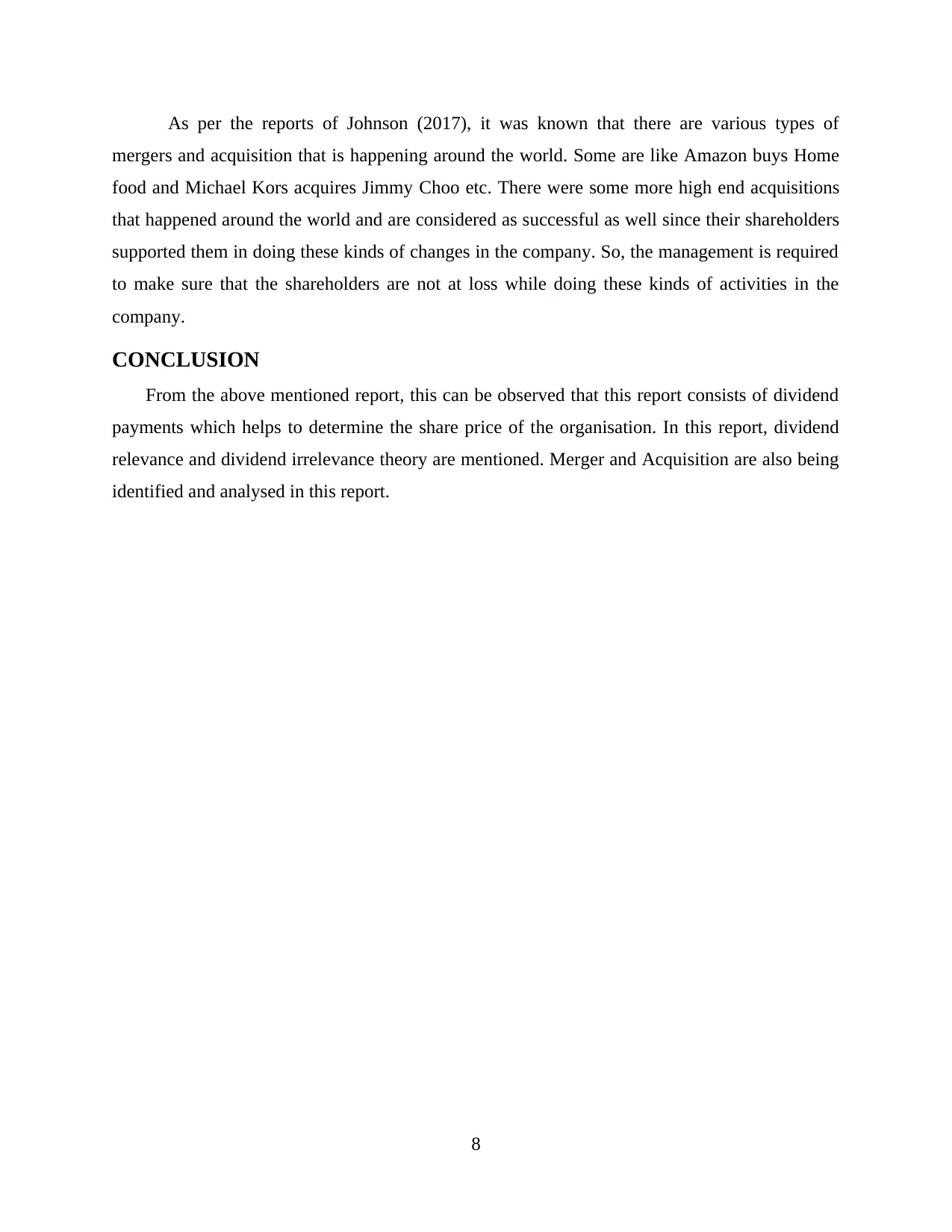
As per the reports of Johnson (2017), it was known that there are various types of
mergers and acquisition that is happening around the world. Some are like Amazon buys Home
food and Michael Kors acquires Jimmy Choo etc. There were some more high end acquisitions
that happened around the world and are considered as successful as well since their shareholders
supported them in doing these kinds of changes in the company. So, the management is required
to make sure that the shareholders are not at loss while doing these kinds of activities in the
company.
CONCLUSION
From the above mentioned report, this can be observed that this report consists of dividend
payments which helps to determine the share price of the organisation. In this report, dividend
relevance and dividend irrelevance theory are mentioned. Merger and Acquisition are also being
identified and analysed in this report.
8
mergers and acquisition that is happening around the world. Some are like Amazon buys Home
food and Michael Kors acquires Jimmy Choo etc. There were some more high end acquisitions
that happened around the world and are considered as successful as well since their shareholders
supported them in doing these kinds of changes in the company. So, the management is required
to make sure that the shareholders are not at loss while doing these kinds of activities in the
company.
CONCLUSION
From the above mentioned report, this can be observed that this report consists of dividend
payments which helps to determine the share price of the organisation. In this report, dividend
relevance and dividend irrelevance theory are mentioned. Merger and Acquisition are also being
identified and analysed in this report.
8
Paraphrase This Document
Need a fresh take? Get an instant paraphrase of this document with our AI Paraphraser
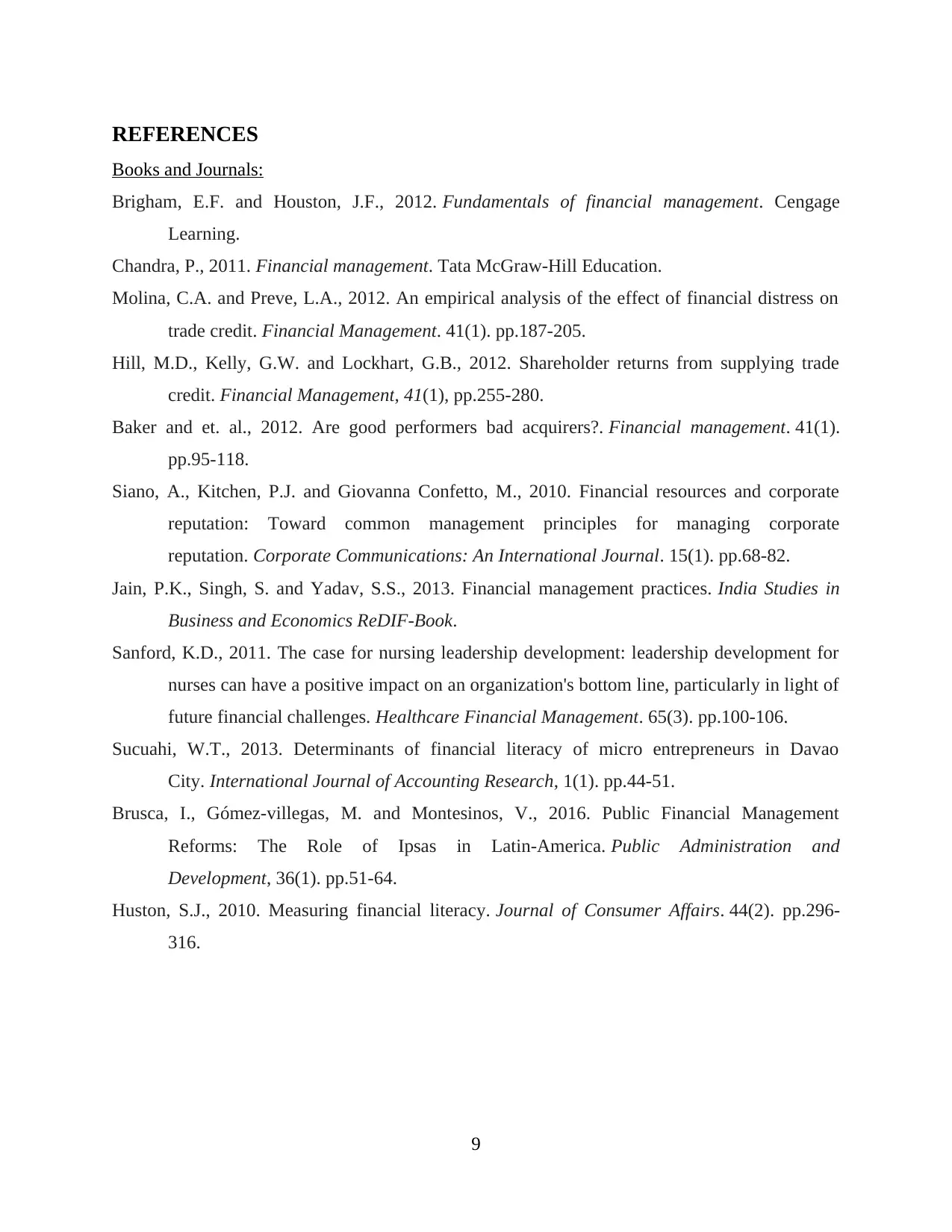
REFERENCES
Books and Journals:
Brigham, E.F. and Houston, J.F., 2012. Fundamentals of financial management. Cengage
Learning.
Chandra, P., 2011. Financial management. Tata McGraw-Hill Education.
Molina, C.A. and Preve, L.A., 2012. An empirical analysis of the effect of financial distress on
trade credit. Financial Management. 41(1). pp.187-205.
Hill, M.D., Kelly, G.W. and Lockhart, G.B., 2012. Shareholder returns from supplying trade
credit. Financial Management, 41(1), pp.255-280.
Baker and et. al., 2012. Are good performers bad acquirers?. Financial management. 41(1).
pp.95-118.
Siano, A., Kitchen, P.J. and Giovanna Confetto, M., 2010. Financial resources and corporate
reputation: Toward common management principles for managing corporate
reputation. Corporate Communications: An International Journal. 15(1). pp.68-82.
Jain, P.K., Singh, S. and Yadav, S.S., 2013. Financial management practices. India Studies in
Business and Economics ReDIF-Book.
Sanford, K.D., 2011. The case for nursing leadership development: leadership development for
nurses can have a positive impact on an organization's bottom line, particularly in light of
future financial challenges. Healthcare Financial Management. 65(3). pp.100-106.
Sucuahi, W.T., 2013. Determinants of financial literacy of micro entrepreneurs in Davao
City. International Journal of Accounting Research, 1(1). pp.44-51.
Brusca, I., Gómez‐villegas, M. and Montesinos, V., 2016. Public Financial Management
Reforms: The Role of Ipsas in Latin‐America. Public Administration and
Development, 36(1). pp.51-64.
Huston, S.J., 2010. Measuring financial literacy. Journal of Consumer Affairs. 44(2). pp.296-
316.
9
Books and Journals:
Brigham, E.F. and Houston, J.F., 2012. Fundamentals of financial management. Cengage
Learning.
Chandra, P., 2011. Financial management. Tata McGraw-Hill Education.
Molina, C.A. and Preve, L.A., 2012. An empirical analysis of the effect of financial distress on
trade credit. Financial Management. 41(1). pp.187-205.
Hill, M.D., Kelly, G.W. and Lockhart, G.B., 2012. Shareholder returns from supplying trade
credit. Financial Management, 41(1), pp.255-280.
Baker and et. al., 2012. Are good performers bad acquirers?. Financial management. 41(1).
pp.95-118.
Siano, A., Kitchen, P.J. and Giovanna Confetto, M., 2010. Financial resources and corporate
reputation: Toward common management principles for managing corporate
reputation. Corporate Communications: An International Journal. 15(1). pp.68-82.
Jain, P.K., Singh, S. and Yadav, S.S., 2013. Financial management practices. India Studies in
Business and Economics ReDIF-Book.
Sanford, K.D., 2011. The case for nursing leadership development: leadership development for
nurses can have a positive impact on an organization's bottom line, particularly in light of
future financial challenges. Healthcare Financial Management. 65(3). pp.100-106.
Sucuahi, W.T., 2013. Determinants of financial literacy of micro entrepreneurs in Davao
City. International Journal of Accounting Research, 1(1). pp.44-51.
Brusca, I., Gómez‐villegas, M. and Montesinos, V., 2016. Public Financial Management
Reforms: The Role of Ipsas in Latin‐America. Public Administration and
Development, 36(1). pp.51-64.
Huston, S.J., 2010. Measuring financial literacy. Journal of Consumer Affairs. 44(2). pp.296-
316.
9
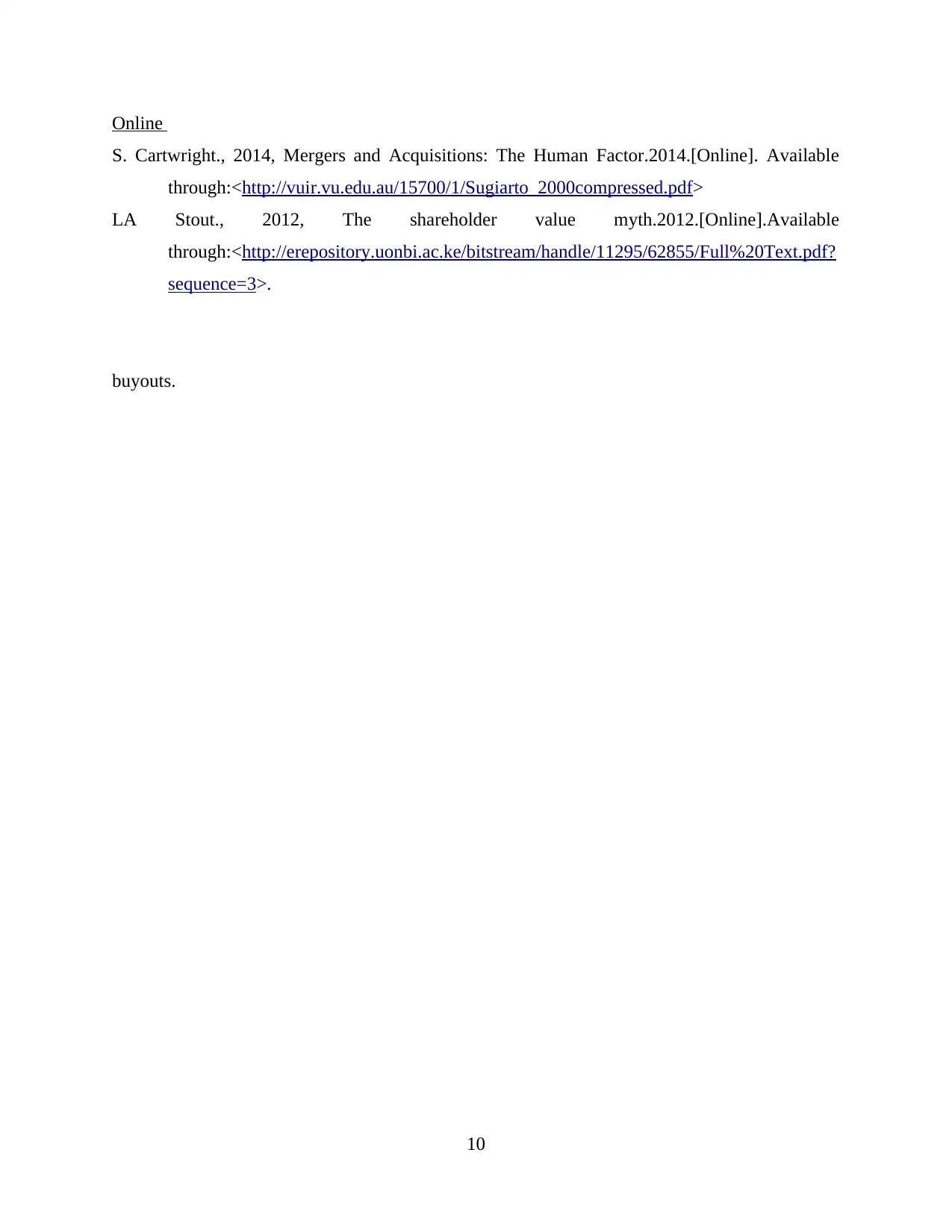
Online
S. Cartwright., 2014, Mergers and Acquisitions: The Human Factor.2014.[Online]. Available
through:<http://vuir.vu.edu.au/15700/1/Sugiarto_2000compressed.pdf>
LA Stout., 2012, The shareholder value myth.2012.[Online].Available
through:<http://erepository.uonbi.ac.ke/bitstream/handle/11295/62855/Full%20Text.pdf?
sequence=3>.
buyouts.
10
S. Cartwright., 2014, Mergers and Acquisitions: The Human Factor.2014.[Online]. Available
through:<http://vuir.vu.edu.au/15700/1/Sugiarto_2000compressed.pdf>
LA Stout., 2012, The shareholder value myth.2012.[Online].Available
through:<http://erepository.uonbi.ac.ke/bitstream/handle/11295/62855/Full%20Text.pdf?
sequence=3>.
buyouts.
10
⊘ This is a preview!⊘
Do you want full access?
Subscribe today to unlock all pages.

Trusted by 1+ million students worldwide
1 out of 12
Related Documents
Your All-in-One AI-Powered Toolkit for Academic Success.
+13062052269
info@desklib.com
Available 24*7 on WhatsApp / Email
![[object Object]](/_next/static/media/star-bottom.7253800d.svg)
Unlock your academic potential
Copyright © 2020–2025 A2Z Services. All Rights Reserved. Developed and managed by ZUCOL.





